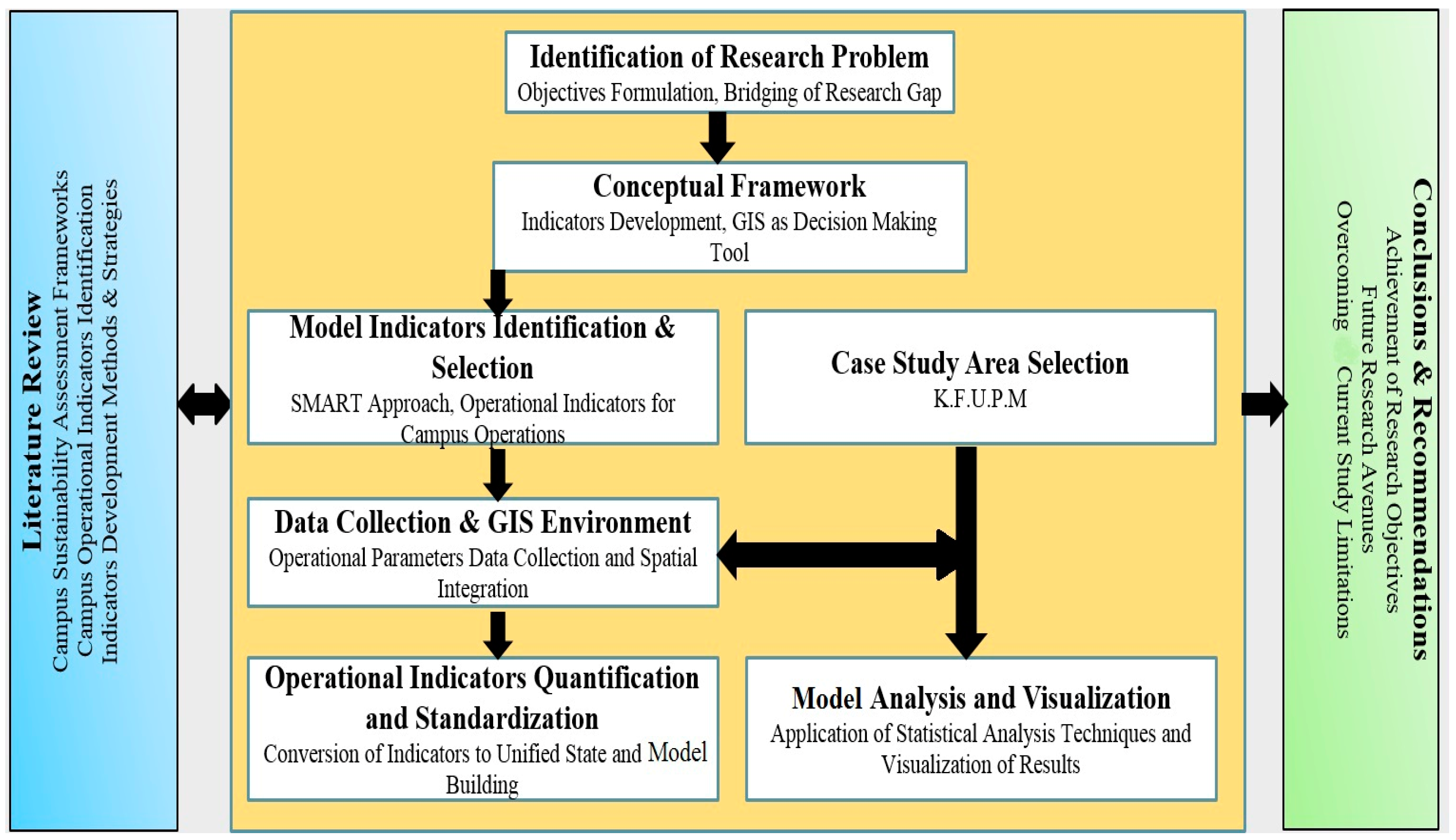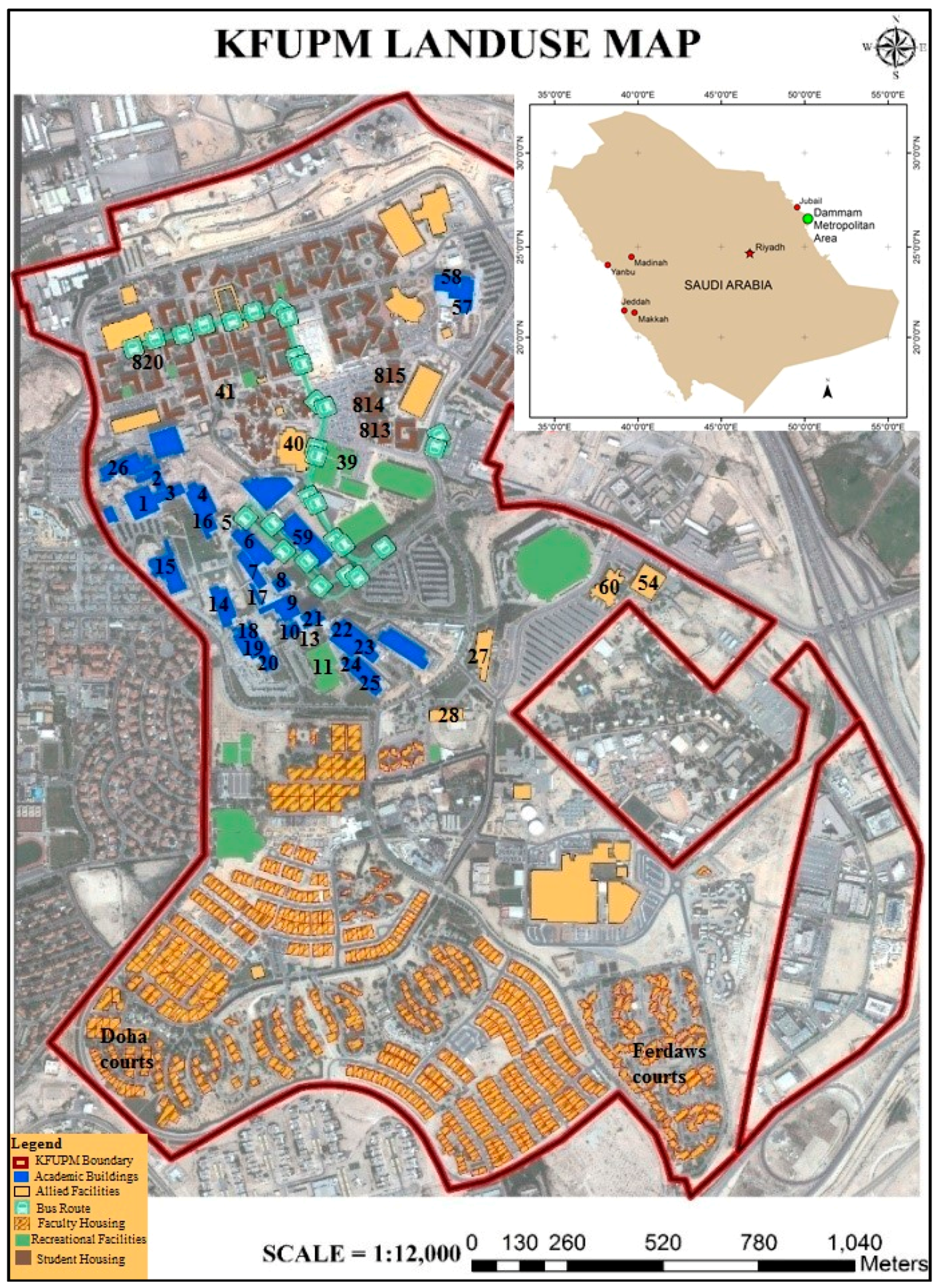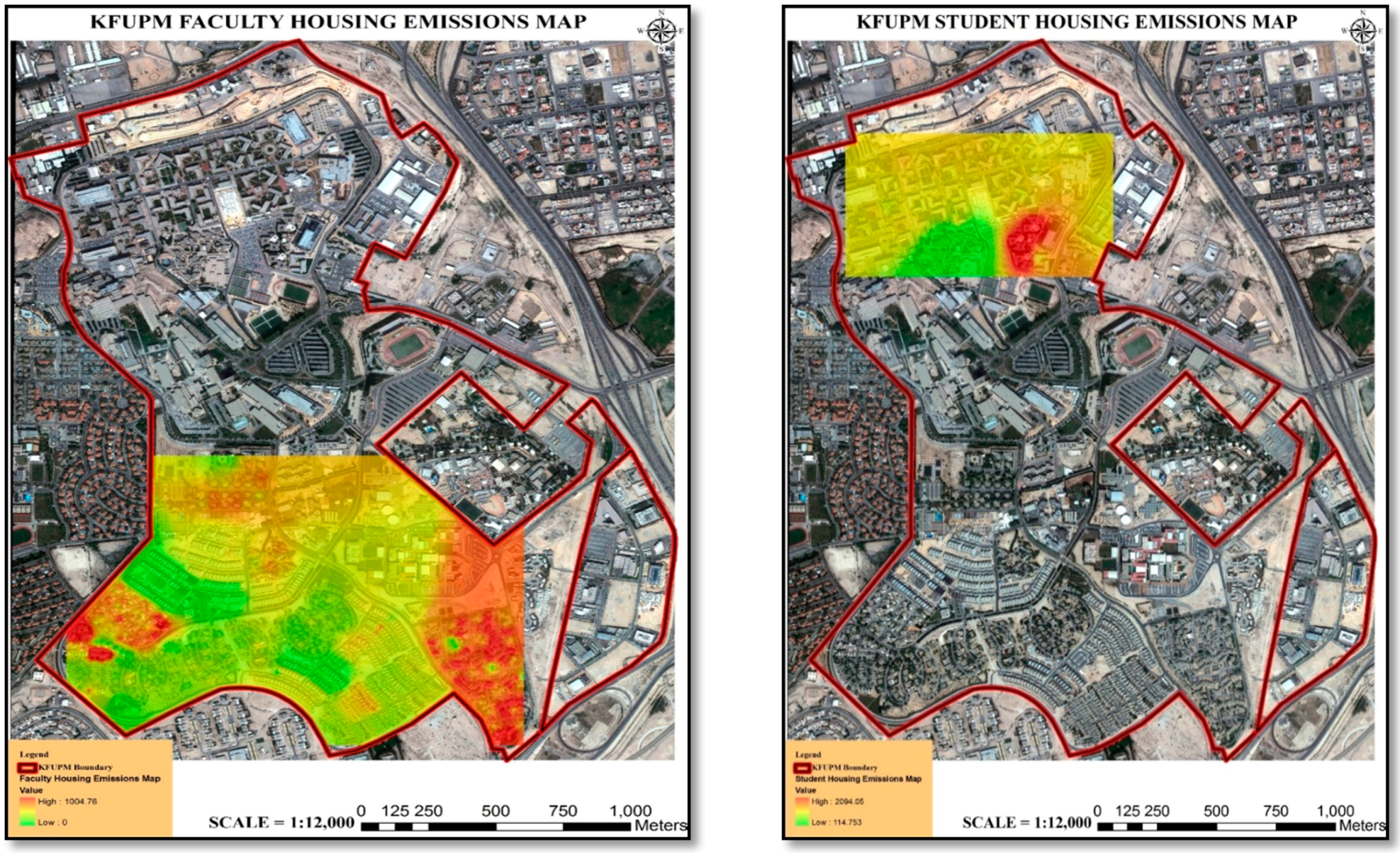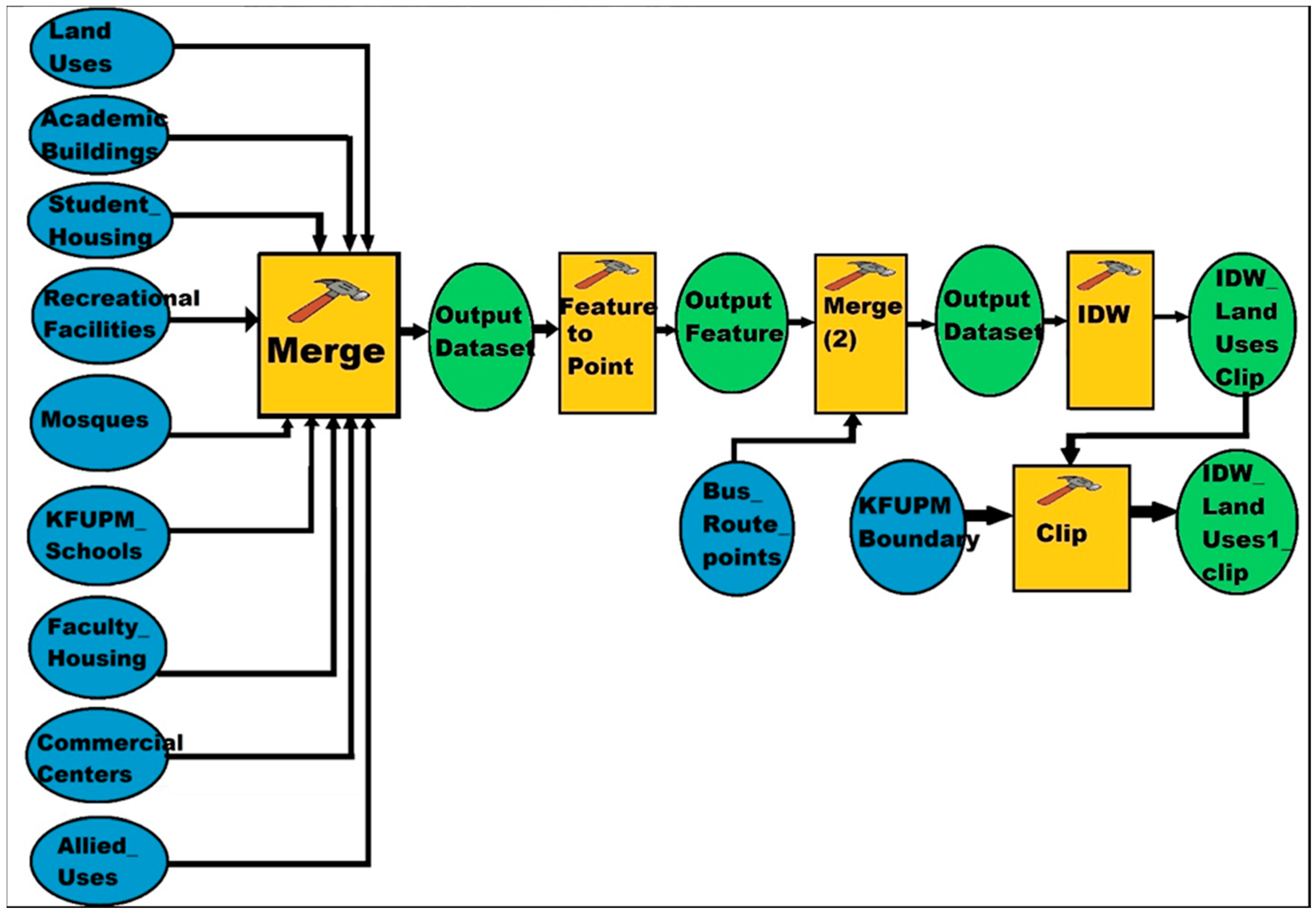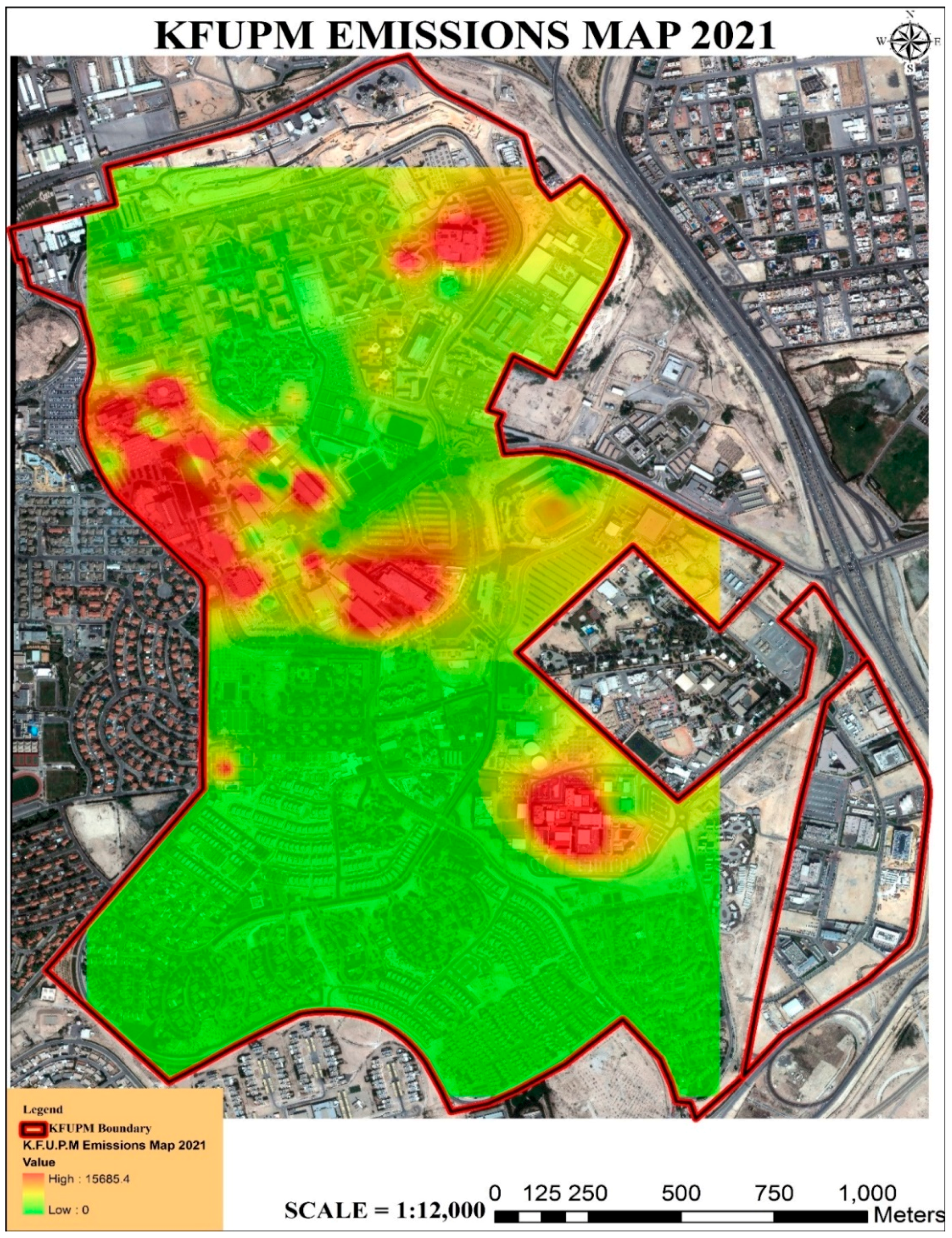2.1. The Imperative of Campus Sustainability Assessment
A sustainable campus is a community that “acts upon its local and global responsibilities to protect and enhance the health and well-being of humans and ecosystems” [
5] (p. 30). Reference to sustainability in colleges and universities was first made by the Stockholm Declaration of 1972, which identified the correlation between the environment and humanity and advocated for universities to play a major role in achieving environmental sustainability. Thereafter, in 1990, administrators from about 300 HEIs from more than 39 countries on five continents signed the Talloires Declaration, which is a 10-point action plan for integrating sustainability and environmental education into research, teaching, campus operations and community outreach. A year later, in Halifax (Canada), university administrators once more intensified campaigns against the persistent and extensive global environmental degradation. During the Swansea Declaration of 1993, members from at least 399 universities in 47 Commonwealth nations stressed the need to discover ways universities could appropriately mitigate the difficulties of balancing human pursuit for technological advancement with environmental protection.
Thus, through charters and declarations as well as pressure from university stakeholders, universities are beginning to gauge their contributions towards achieving sustainability within and outside their campuses [
14,
15]. This is because universities play a key role in urban sustainability that include: (a) reducing the negative environmental impact of campus operations and collaborate with public and private sectors, organizations and communities to deploy and implement sustainable practices [
16]; (b) producing knowledge and innovation technologies required to contribute in finding solutions to global environmental problems [
17]; and (c) preparing future leaders, managers of companies and organizations, and entrepreneurs of new businesses, with competencies required to create a more sustainable communities [
2,
18,
19].
As such, several universities are nowadays taking more responsibility in managing their environmental performance by conducting sustainability assessments and taking initiatives towards improving their campus environment [
20,
21]. Sustainability assessment has thus emerged as a policy tool whose main purpose is to guide planning decision-making towards environmental sustainability [
22]. The term is operationalized in both theory and practice in two distinct ways. First, it is used in checking whether a community or organization is making progress towards sustainability: serving as a technique for performance testing or auditing. Second, it is used for impact assessment process to assess whether proposed policies, legislation, plans or projects are sustainable before their implementation [
23]. The quality of sustainability assessment depends on the indicators used and several studies on living green and creating new sustainable communities have stressed the importance of deriving indicators and integrating GIS in sustainability assessment [
6,
10,
11,
13]. A university can assess to what extent it is moving towards sustainability based on the following seven core dimensions [
24].
- (a)
Teaching and curriculum that incorporate sustainability into learning capabilities such as knowledge, skills, and attitudes, so that students are prepared to deal with local and global sustainability issues;
- (b)
Reorienting research and scholarship activities and funding to focus more on sustainability issues, interdisciplinary and new knowledge and technologies that can address the contemporary global challenges;
- (c)
Campus operations that involve environmental sustainability of everything that keeps the university running, such as green buildings and transportation, sustainable waste management, water and energy conservation, pollution control, health, and wellbeing;
- (d)
Institutional framework and governance that involves university policies, missions/visions, signing of declaration/charter and sustainability management;
- (e)
Community outreach and collaboration on issues that enhance sustainable development, including community services, student exchange program and partnerships with public and private sectors, and non-governmental organizations;
- (f)
On-campus experiences that utilize the university as a “living laboratory” where sustainable practices for students, faculty, and staff are available; and
- (g)
Sustainability assessment and reporting, which is the subject of this study.
Within the last two decades, stakeholders have been exerting considerable pressure on universities to periodically conduct and report campus sustainability assessments [
2,
22]. Some benefits of the assessments include assisting universities to understand where they stand in terms of their sustainability goals or objectives as well as discover problem areas and develop strategies for improvement. Also of importance is the role universities are making in the community as well as that of the community on the universities; and to commit universities and their stakeholders to the course of sustainability [
5,
25]. According to Dalal-Clayton and Bass, there are three main approaches to sustainability assessment [
26]:
(i)
Indicator-based assessments: These rely on the use of indicators, chosen systematically to cover a wide range of issues that adequately portray sustainability conditions. As a similar set of indicators were usually used over time, current assessment is comparable with previous ones, thus allowing more consistent coverage from one assessment and reporting period to another. These approaches are not only comprehensive but they also systematically organize and prioritize issues as well as their indicators. Given that they allow clear identification of the strengths and weaknesses of universities, they are more suitable than other approaches for decision-making, performance monitoring, and strategy development. Lukman et al. posited further that because indicator-based assessments are more objective and transparent [
27], they are more easily measurable and have higher performance when compared with the other two approaches.
(ii) Narrative assessments: These use a combination of texts, tables, graphs, and maps to describe the overall sustainability performance of a university or city. They represent the most familiar standard approach to environmental measurement. Notable examples are the global health, environment and development reports of the World Health Organization (WHO), UN-Habitat and the World Bank. The major strength of these approaches is that they are familiar, flexible and promote participation, and the assessment can be tailored to the technical skills of participants. However, these approaches are less suitable for campus sustainability assessment as they lack transparency and do not allow trends identification. In addition, parameters are neither consistent nor systematically chosen, thus limiting their worth for making decisions, monitoring progress and developing strategies.
(iii) Accounts of sustainability status: These involve the use of raw data, usually converted to a common unit for measuring and analyzing typically small aspects of environmental sustainability. These approaches can cover some aspects of campus’ environment, society and the economy, such as material and energy account, ecological footprint, and resource consumption, aggregated into a single statement of the sustainability status. Nevertheless, among the drawbacks of sustainability accounts that make them less suitable for campus sustainability assessment include their reliance on values, judgments, assumptions, as well as the lack of consistency, the possibility of omitting some parameters, and fewer opportunities for wide stakeholder involvement.
The development of sustainability assessment indicators has gone through many stages. In the 1970s, cities, agencies and organizations assess the performance of their systems based on financial, technical and social criteria. During the 1980s, carbon emissions, and environmental degradation were the prime focus of sustainability assessment practices. From 1990s, both academic research, as well as practice, started to look at environmental in conjunction with socio-economic issues for sustainability assessment, although sustainability assessment and reporting in many universities focuses more on campus greening [
28].
2.2. Shortcomings of the Existing Campus Sustainability Indicator Frameworks
Campus sustainability assessment is primarily based on sets of indicators and guidelines formulated under a framework or a rating system, which compile information based on certain criteria and combine them during the assessment to come up with results regarding sustainability ranking or standing of a university campus. However, there is a lack of integration of sustainability assessment indicators with spatial dimension of academic campuses even though they have diverse land uses, complex operations and activities covering a substantial geographical area and with severe environmental impacts.
Certainly, spatial dimension is imperative for more effective environmental sustainability assessment. To more effectively carry out complex decision or problem solving such as sustainability assessment in large environments such as university campuses, there is the need to integrate data with spatial dimension and analyze data using spatial techniques. This need has been recognized and has given rise to integration of GIS into environmental sustainability assessment and a research stream called Spatial Decision Support Systems (DSS). As mentioned by Maniezzo et al., DSS integrates spatially referenced information in a decision-making environment to positively affect the performance of decision makers, showing how spatially integrated DSS can be used to bridge the gap between policy makers and complex computerized models [
29].
However, a review of available literature indicates that no such kind of GIS integration with sustainability assessment campuses has been investigated, nor has any framework been formulated to integrate campus sustainability assessment indicators to their spatial domain. This is despite calls by several scholars for the integration of spatial dimension into sustainability assessment [
6,
7,
8,
12,
13]. Even the popular campus sustainability assessment and rating systems, Sustainability Tracking, Assessment and Rating Systems (STARS) and Global Reporting Initiative (GRI), despite their strengths lack GIS integration in their campus assessment guidelines. These two systems are hereby analyzed because of the increasing trend in the number of HEIs using their guidelines. As shown in
Table 1, the number of universities participating in STARS reporting more than tripled from 246 in 2011 to 787 in 2016, while those participating in GRI have increased six-fold from 12 to 72 within the same period.
The STARS framework is designed to incorporate all levels of academic institutions, both public and private. The system is designed to assess the sustainability of academic institutions irrespective of their history in sustainability assessment; it is equally feasible and applicable to starters as well as long-term users [
33]. It encompasses long-term sustainability goals for HEIs planning to conduct sustainability assessment, as it focuses on academics, engagements, operations, and planning and administration [
33]. It is one of the most widely used tools for campus sustainability assessment and certification, which has been adopted largely by North American universities. In their review of STARS, Sonetti et al. opined that its major strength is its preference for performance over strategy and sustainability appraisal based on results and current situation while enabling comparison among institutions using common criteria [
34]. However, in STARS’ technical manual, the reference to GIS was only as a sustainability course for earning points if the focus of the HEI offering it is on sustainability applications or as a unit or module in a sustainability course [
35]. Despite the availability of indicators with spatial dimension in the assessment criteria of STARS, its assessment framework used redundant criteria [
36], assign similar weight to each category [
30] and has limited ability to spatially assess campus environmental operational indicators, thus requiring more efforts to make it more acceptable to HEIs [
36].
GRI is another framework for sustainability assessment and reporting. Though its guidelines were developed for companies, an increasing number of universities have adopted its guidelines (
Table 1). Like the STARS, the GRI guidelines have assessment categories for various dimensions of sustainability [
37] although the adoption of GRI at universities is still at an early stage [
38,
39]. According to Bice and Coates, the GRI framework has been useful in capturing the environmental aspects of sustainability at the universities [
40]. However, the lack of spatial dimension in sustainability assessment of HEIs by both STARS and GRI show their inability to spatially referenced information in a decision-making environment that positively affect the performance of decision makers. Though the guidelines of GRI incorporates environmental aspects of performance indicators that include materials, energy, water, effluents and waste, emission, and transport [
31], GIS and spatial dimension were not integrated into these indicators.
In general, the guidelines of both STARS and GRI frameworks neither include GIS nor integrate spatial dimension in campus sustainability assessment and reporting. These deficiencies could result to assessing land uses and campus operations individually and that campus managers require taking extra steps to interpret assessment result across the campus. Similarly, lack of GIS integration could lead to more cost in preparing, storing and updating data, including maps, as well as the lack of visualization of the state of campus environmental sustainability. Thus, the proposed model helps to fill these gaps.
Indeed, the importance of integrating GIS in campus environmental sustainability assessment includes the following.
GIS establishes a framework for collection, storage, analysis and display of both geographical as well as non-geographical data of university campus collected from multiple sources (university department, remote sensing images, fieldwork, etc.) which can then be consolidated, efficiently organized and managed for utilization as input into assessing the environmental sustainability of the campus [
6,
7,
13].
In addition, GIS can be used to develop a database of environmental sustainability indicators and produce thematic maps to visualize the state of sustainability on a campus. Because GIS provides the integration of the indicators with their unique location, necessary linkage between the location and sustainability characteristics of campus buildings and land uses can be easily made [
8,
12].
GIS-based assessment framework can provide a comprehensive digital data base and indicators related to campus environment and operations (e.g., energy and water use, transportation, waste management, and air quality) that can be updated to assess campus sustainability after regular intervals of time. This data base will not only help in continuous monitoring of campus sustainability but will also save cost in campus sustainability assessment process [
13].
Similarly, an integrated framework can provide the authorities with ample room to test various scenarios and situations, presently and in the future. GIS provides the user with the ability to visualize various situations using different parameters. Indicators can be manipulated and visualized to see the possible outcome of any sustainability initiative or measures. The GIS-based framework is also useful in sustainability reporting [
6,
7,
8,
9].
It could also assist in developing a university site plans and details of campus environment including buildings, research and storage facilities, utilities as well as condition of other land uses in the campus. It allows mapping areas with potential environmental risks and opportunities for improvement, which can assist in classifying structures and facilities based on their degree of environmental impacts [
10,
13].
Because GIS facilitates the extraction of data from secondary sources such as satellite imagery and online maps, spatially referenced data set can be developed which can assist minimize the problem of lack of access to data and reduce the costs of conducting sustainability assessment [
6,
12].
